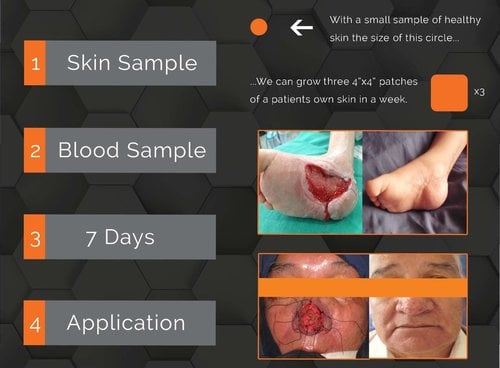

MyOwn Skin™ is an autologous( meaning your own) skin grafting office procedure using a small donor piece of the patient’s own skin and a few tubes of the patient’s blood from which we grow a large partial thickness skin graft in the lab in about 7 days. This is then transplanted onto a burn or wound and healing starts immediately!
What is the healing process like after a skin graft?
The healing process after a skin graft involves several stages:
- Immediate Post-Operative Phase:
After the procedure, the graft is initially held in place with dressings, sutures, or staples. The graft and donor site are covered to protect against infection, provide a stable environment, and facilitate initial blood supply.
- Adherence and Vascularization:
Over the next few days, the graft starts adhering to the recipient site. New blood vessels from both the graft and the recipient site grow into the graft, supplying it with nutrients and oxygen.
- Initial Healing:
Within the first week or so, the graft develops a blood supply and turns pink as it heals. The graft may appear swollen and might require careful monitoring for signs of complications.
- Graft Contraction:
As the graft heals, it might contract, causing it to shrink slightly. This can sometimes lead to a change in the appearance of the graft and the surrounding skin.
- Epithelialization:
Over the following weeks, the graft’s surface starts to heal and become covered by a layer of new skin cells called epithelium. This process might take several weeks to complete, and the graft may appear uneven or discolored during this phase.
- Maturation and Final Appearance:
Over several months, the graft continues to mature. The appearance gradually improves, although some color and texture differences may persist between the graft and the surrounding skin.
- Scar Management:
After the graft is fully healed, scar management techniques such as massage, pressure garments, and topical treatments might be recommended to help improve the appearance of the graft site.
- Functional Rehabilitation:
If the graft was applied to a functional area, physical therapy might be necessary to restore range of motion and function.
- Long-Term Monitoring:
Regular follow-up appointments with the healthcare provider are essential to ensure proper healing, address any concerns, and monitor for potential complications.
MyOwn Skin™ is a painless, non surgical procedure which leverages a small sample of a patient’s own skin to produce up to three 100cm² skin grafts in a week.

